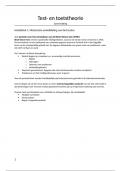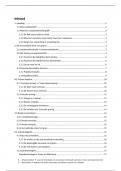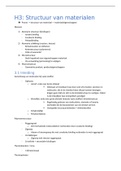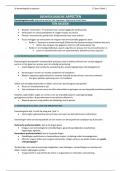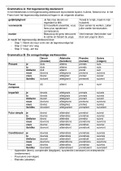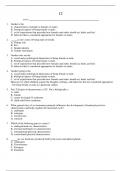SUMMARY FORENSIC AND LEGAL PSYCHOLOGY
IN A NUTSHELL
LEARNING GOALS:
Case 1:
1. Are people with mental disorders more likely to commit a crime than people without mental disorders?
2. What factors contribute to the expression of violent behavior in the mentally ill?
3. How are people with mental disorders treated in different legal systems?
4. Are mentally ill people morally/legally responsible for their crimes?
Case 2:
1. What is infanticide, neonaticide and filicide?
2. Which psychopathology is related to those 3?
3. What role does postnatal depression play?
4. What can cause infanticide in the absence of psychopathology?
5. Are there differences between filicidal mothers and fathers?
6. How can we prevent infanticide, neonaticide and filicide?
Case 3:
1. What is paraphilia? What are different types, crimes, and causes/risk factors?
2. To what extend are pedophiles treatable?
3. What actions get you on the sex offender register?
4. Are there ways to measure in a lab if a person has a specific type of paraphilia?
5. How do different countries handle sex offenders?
6. How effective are the laws about recidivism? (Negative consequences for perpetrator and community)
Case 4:
1. How does sleep work?
a. In which phase does sleepwalking happen?
b. What are other types of sleep disorders?
2. How are sleep disorders related to violence?
3. Which factors can trigger sleep disorders?
4. What is the role of proximity?
5. Is this kind of violence sane or insane automatism? How about culpability?
6. How can you determine if sleep disorder was underlying an offence?
7. Is there a possibility to treat sleepwalking?
Case 5:
1. Do children lie? Why?
2. How does lying develop?
3. How can you detect lying?
4. What is credibility assessment?
a. What existing methods are there?
b. How successful are these methods? (Pros, cons, accuracy)
c. Which methods are used in practice?
d. How is it affected by coaching?
e. How do you detect coaching?
5. How do these assessments work?
a. What factors are being looked at in these assessments?
6. What factors influence credibility itself? (Certain factors make children more/less credible)
Case 6:
1. What is profiling?
2. How do you come up with a profile?
3. What are limitations and potentials of profiling? (Accuracy and usefulness)
4. What are different approaches to profiling?
a. What are the underlying assumptions?
b. What is the empirical evidence for these assumptions?
5. Why is it popular to profile?
, CASE 1: ALL THOSE VIOLENT LUNATICS!
ELBOGEN & JOHNSON (2009): LINK BETWEEN VIOLENCE AND MENTAL DISORDER
Longitudinal data set representative of the US population to clarify whether or how severe mental
illnesses such as schizophrenia, bipolar disorder, and MDD lead to violent behavior.
Aim: using longitudinal data to examine (1) what risk factors prospectively predict violent
behavior; (2) whether severe mental disorders predict future violent behavior; and (3) how
different risk factors may predict different types of violence.
Method:
o Participants > 18 years.
o 2 waves:
Wave 1 from 2001-2003.
Wave 2 from 2004-2005
Results:
o Analysis showed that the incidence of violence was higher for people with severe mental
illness, but only significantly for those with co-occurring substance abuse and/or
dependence.
o Severe mental illness alone did not predict future violence: it was associated instead with
historical, clinical, dispositional, and contextual factors. Most of these factors were
endorsed more often by subjects with severe mental illness.
Conclusions:
o Several mental illnesses did not independently predict future violent behavior,
so this challenges the perceptions that mental illness is a leading cause of violence in the
general population.
o People with mental illness did report violence more often, largely because they showed
other factors associated with violence.
o No causal role of mental illness in violence.
Limitations: people were self-reporting Biased (especially in people with schizophrenia).
KINGSTON ET AL. (2016): RELATIONSHIP BETWEEN MENTAL ILLNESS AND VIOLENCE IN A
MENTALLY DISORDERED OFFENDER SAMPLE
Psychopathological Theory of Criminal Behavior: untreated mental illness, particularly
schizophrenia and other psychotic disorders is a direct cause of criminal behavior.
There are 8 predictors of criminal behavior that reside within the individual or their immediate social
learning environment:
1. Criminal history
2. Pro-criminal companions
3. Pro-criminal attitudes
4. Antisocial personality pattern
5. Education/employment
6. Family/marital
7. Substance abuse
8. Leisure/recreation
These 8 risk factors were important predictors of general/violent recidivism among mentally ill
offenders, whereas clinical/mental health variables were not significant predictors.
Moderators between mental illness and violence:
1. History of violence
2. Age of onset (together with persistence of offending):
o Early start offenders: display early pattern of antisocial and criminal behavior that
commences prior to the onset of mental illness.
More exposed to criminogenic risk factors and are embedded in criminogenic
environments.
More diverse criminal activity, convicted for more nonviolent and violent crimes,
and have more problems with substance abuse.
Increased prevalence of antisocial personality disorder diagnoses, psychopathic
traits, history of prison infractions.
2
IN A NUTSHELL
LEARNING GOALS:
Case 1:
1. Are people with mental disorders more likely to commit a crime than people without mental disorders?
2. What factors contribute to the expression of violent behavior in the mentally ill?
3. How are people with mental disorders treated in different legal systems?
4. Are mentally ill people morally/legally responsible for their crimes?
Case 2:
1. What is infanticide, neonaticide and filicide?
2. Which psychopathology is related to those 3?
3. What role does postnatal depression play?
4. What can cause infanticide in the absence of psychopathology?
5. Are there differences between filicidal mothers and fathers?
6. How can we prevent infanticide, neonaticide and filicide?
Case 3:
1. What is paraphilia? What are different types, crimes, and causes/risk factors?
2. To what extend are pedophiles treatable?
3. What actions get you on the sex offender register?
4. Are there ways to measure in a lab if a person has a specific type of paraphilia?
5. How do different countries handle sex offenders?
6. How effective are the laws about recidivism? (Negative consequences for perpetrator and community)
Case 4:
1. How does sleep work?
a. In which phase does sleepwalking happen?
b. What are other types of sleep disorders?
2. How are sleep disorders related to violence?
3. Which factors can trigger sleep disorders?
4. What is the role of proximity?
5. Is this kind of violence sane or insane automatism? How about culpability?
6. How can you determine if sleep disorder was underlying an offence?
7. Is there a possibility to treat sleepwalking?
Case 5:
1. Do children lie? Why?
2. How does lying develop?
3. How can you detect lying?
4. What is credibility assessment?
a. What existing methods are there?
b. How successful are these methods? (Pros, cons, accuracy)
c. Which methods are used in practice?
d. How is it affected by coaching?
e. How do you detect coaching?
5. How do these assessments work?
a. What factors are being looked at in these assessments?
6. What factors influence credibility itself? (Certain factors make children more/less credible)
Case 6:
1. What is profiling?
2. How do you come up with a profile?
3. What are limitations and potentials of profiling? (Accuracy and usefulness)
4. What are different approaches to profiling?
a. What are the underlying assumptions?
b. What is the empirical evidence for these assumptions?
5. Why is it popular to profile?
, CASE 1: ALL THOSE VIOLENT LUNATICS!
ELBOGEN & JOHNSON (2009): LINK BETWEEN VIOLENCE AND MENTAL DISORDER
Longitudinal data set representative of the US population to clarify whether or how severe mental
illnesses such as schizophrenia, bipolar disorder, and MDD lead to violent behavior.
Aim: using longitudinal data to examine (1) what risk factors prospectively predict violent
behavior; (2) whether severe mental disorders predict future violent behavior; and (3) how
different risk factors may predict different types of violence.
Method:
o Participants > 18 years.
o 2 waves:
Wave 1 from 2001-2003.
Wave 2 from 2004-2005
Results:
o Analysis showed that the incidence of violence was higher for people with severe mental
illness, but only significantly for those with co-occurring substance abuse and/or
dependence.
o Severe mental illness alone did not predict future violence: it was associated instead with
historical, clinical, dispositional, and contextual factors. Most of these factors were
endorsed more often by subjects with severe mental illness.
Conclusions:
o Several mental illnesses did not independently predict future violent behavior,
so this challenges the perceptions that mental illness is a leading cause of violence in the
general population.
o People with mental illness did report violence more often, largely because they showed
other factors associated with violence.
o No causal role of mental illness in violence.
Limitations: people were self-reporting Biased (especially in people with schizophrenia).
KINGSTON ET AL. (2016): RELATIONSHIP BETWEEN MENTAL ILLNESS AND VIOLENCE IN A
MENTALLY DISORDERED OFFENDER SAMPLE
Psychopathological Theory of Criminal Behavior: untreated mental illness, particularly
schizophrenia and other psychotic disorders is a direct cause of criminal behavior.
There are 8 predictors of criminal behavior that reside within the individual or their immediate social
learning environment:
1. Criminal history
2. Pro-criminal companions
3. Pro-criminal attitudes
4. Antisocial personality pattern
5. Education/employment
6. Family/marital
7. Substance abuse
8. Leisure/recreation
These 8 risk factors were important predictors of general/violent recidivism among mentally ill
offenders, whereas clinical/mental health variables were not significant predictors.
Moderators between mental illness and violence:
1. History of violence
2. Age of onset (together with persistence of offending):
o Early start offenders: display early pattern of antisocial and criminal behavior that
commences prior to the onset of mental illness.
More exposed to criminogenic risk factors and are embedded in criminogenic
environments.
More diverse criminal activity, convicted for more nonviolent and violent crimes,
and have more problems with substance abuse.
Increased prevalence of antisocial personality disorder diagnoses, psychopathic
traits, history of prison infractions.
2


